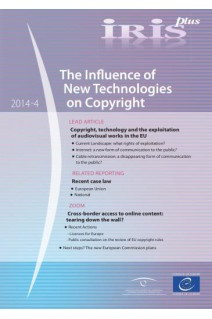- Exclusivité web !



Our means of accessing copyrighted works have been transformed beyond recognition by the digital revolution. On line services, streaming, torrents and all other digital means of content delivery are challenging the current framework of copyright legislation. Indeed, it seems that the rule makers are always chasing behind the latest technological developments in order to provide a suitable regulatory structure. This last IRIS plus report of 2014 looks at the ever widening gap between current copyright legislation for audiovisual content and the technologically transformed playing field it is supposed to regulate…
The Influence of New Technologies on Copyright – time for an overhaul of our legislation in Europe?
LEAD ARTICLE
Copyright, Technology and the Exploitation of Audiovisual Works in the EU
The lead article of this new publication is authored by Lucia Guibault and João Pedro Quintais of the Amsterdam-based Institute for Information Law (IViR). The article focuses on criteria developed by the European Court of Justice (CJEU) to judge whether or not there has been “communication to the public” under the terms of the InfoSoc Directive. These criteria are also examined with regards to their application to newer means of distribution such as live streams of TV broadcasts or hyper-linking to internet sites, for example.
Lead article chapter headings:
I. Introduction
II. Current Landscape: what rights of exploitation?
1. Legal Framework
1) The identity of the ‘user’
2) Definition of the ‘public’
3) The profit-making nature of communication to the public
4) The concept of ‘new’ public
2. Rights of exploitation in the audiovisual sector
III. Internet: a new form of communication to the public?
1. Live streams of TV broadcasts
2. Hyper-linking to websites on the internet and the ‘new public’ criterion
IV. Cable retransmission: a disappearing form of communication to the public?
IV. Conclusions
RELATED REPORTING
Recent Case Law
The Related Reporting section of this new publication provides short articles on recent developments in private copying and liability in the case of online infringement. Cases of non-liability are also included.
Related reporting chapter headings:
European Union
• Court of Justice of the European Union
• Advocate General
• Court of Justice of the European Union
National
• Germany
• Spain
• Netherlands
• United States
ZOOM
Cross-border access to online content: tearing down the wall?
The Zoom section has been written by the Observatory’s two legal analysts, Francisco Cabrera Blázquez and Sophie Valais. This final chapter looks at cross-border access to online content with an overview of the most recent initiatives taken at EU level. The thorny question of “licences for Europe”, stakeholder dialogue and the public consultation on the review of EU copyright rules were launched in 2013. Cabrera and Valais conclude by looking at the announcements made by the newly elected Commission regarding future programmes.
Zoom article chapter headings:
I. Introduction
II. Recent Actions
III. Next steps? The new European Commission plans

Our means of accessing copyrighted works have been transformed beyond recognition by the digital revolution. On line services, streaming, torrents and all other digital means of content delivery are challenging the current framework of copyright legislation. Indeed, it seems that the rule makers are always chasing behind the latest technological developments in order to provide a suitable regulatory structure. This last IRIS plus report of 2014 looks at the ever widening gap between current copyright legislation for audiovisual content and the technologically transformed playing field it is supposed to regulate…
The Influence of New Technologies on Copyright – time for an overhaul of our legislation in Europe?
Attention, en vertu de nos conditions générales de vente, l'achat des PDF/epub est réservé aux particuliers.
